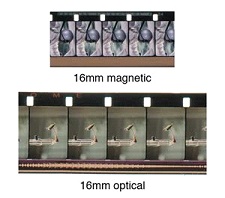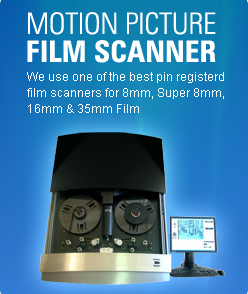
Regular 8mm movie film was never sold commercially with a sound strip but some people did attach a sound strip themselves. Super 8 film has the option but you had to buy the film with the sound strip on it and you had to have a sound camera and microphone. 16mm had both magnetic and optical. On the order form you can let us know if you think your film has sound on it. It does take extra effort to capture the sound and incorporate it into the requested formats. So, we do charge a little more for sound film.
We can not capture any digital audio like Dolby Digital or Sony Dynamic Digital Sound.


The above picture is just an example. 16mm sound film came in many different varieties. 16mm film with optical sound will have sprocket holes on 1 side. The other side will carry the audio track.
There is no sound on Regular 8 film. At least it wasn't produced that way. There were some people that put a magnetic sound strip on 8mm film themselves. There was also some test 8mm film with sound that Kodak used to prepare for Super 8 film.
Even though Super 8 film was sold in two versions, sound and silent, most Super 8 film is silent. Only about 5% of all Super 8 movie film has sound on it.
Super 8 sound could be recorded with a microphone during filming or could also be recorded using a projector when the film played. The quality of the sound varied widely.
Columbus Fun Facts: Originally settled by Native Americans, the area that became Columbus (named after Christopher Columbus) was settled by white explorers in the 1700s and made the state capital in 1816. Roads, railroads and the Ohio Canal energized the city; during World War II, aircraft manufacturing brought additional growth. Today, Columbus is a fast-growing, major American city with a population of more than 700,000 and a strong economy that is not dependent on any one industry. Its leading employers include government agencies and manufacturers of transportation equipment, textiles, metals and consumer goods.
Ohio Fun Facts: Initially colonized by French fur traders, Ohio became a British colonial possession following the French and Indian War in 1754. At the end of the American Revolution, Britain ceded control of the territory to the newly formed United States, which incorporated it into the Northwest Territory. Ohio became a state on March 1, 1803, although no formal declaration was madeuntil 1953, when President Dwight Eisenhower officially signed the documents making it a state, retroactive to the original date.Ohio issometimes called the “Mother of Modern Presidents,” having sent seven Ohioans (both natives and residents)to the White House since 1869. Ohio is also known as the home of the Rock and Roll Hall of Fame in Cleveland, the NationalUnderground RailroadFreedom Centerin Cincinnati and National Football League Hall of Fame in Canton.





